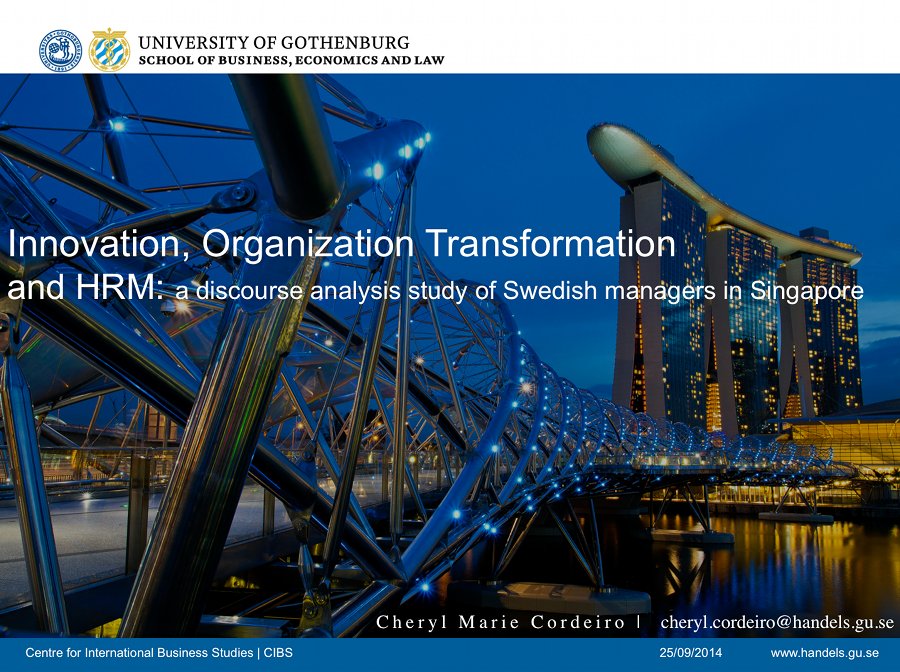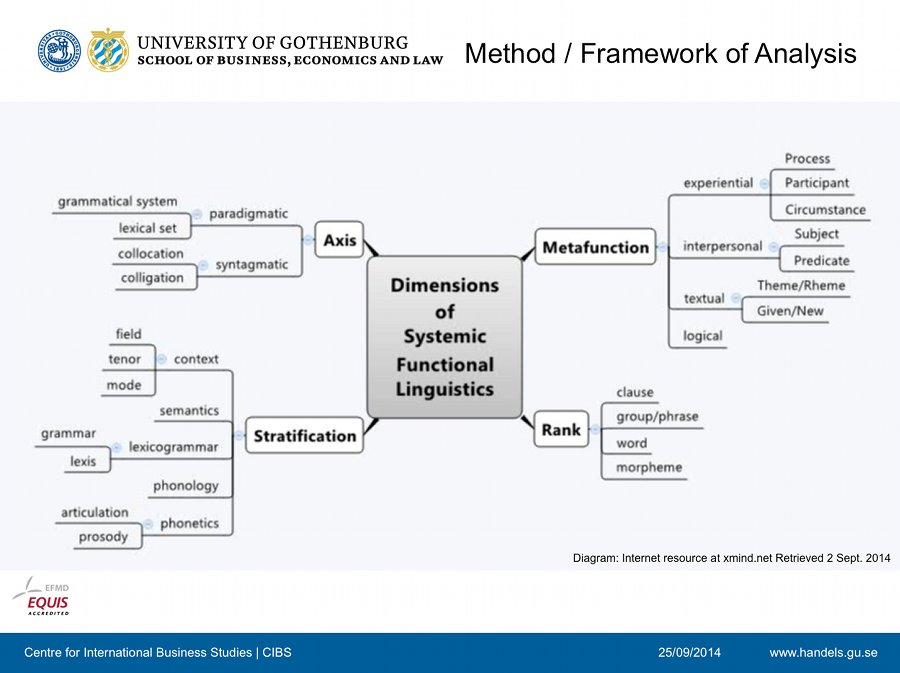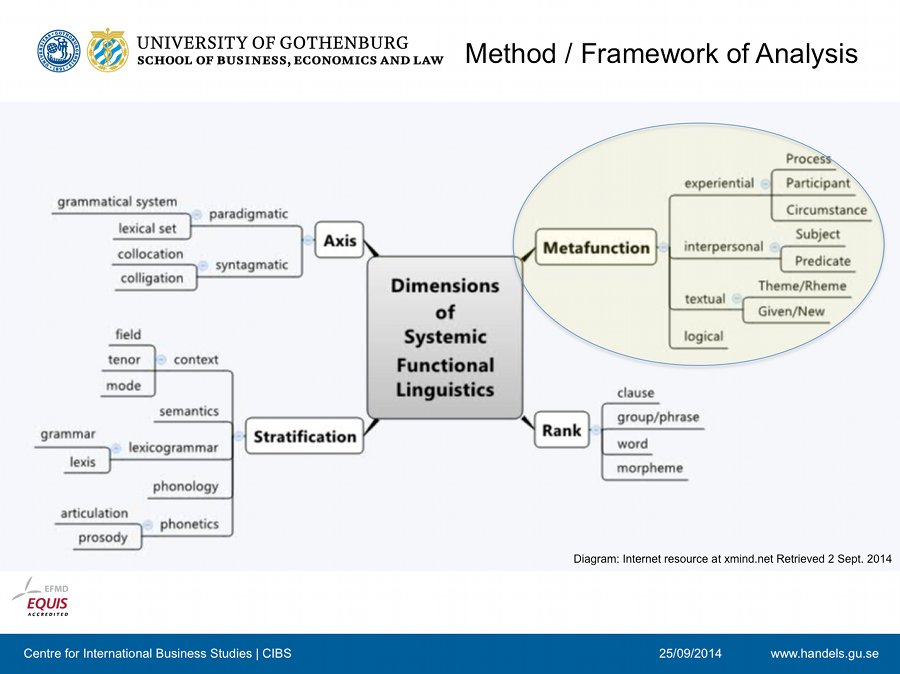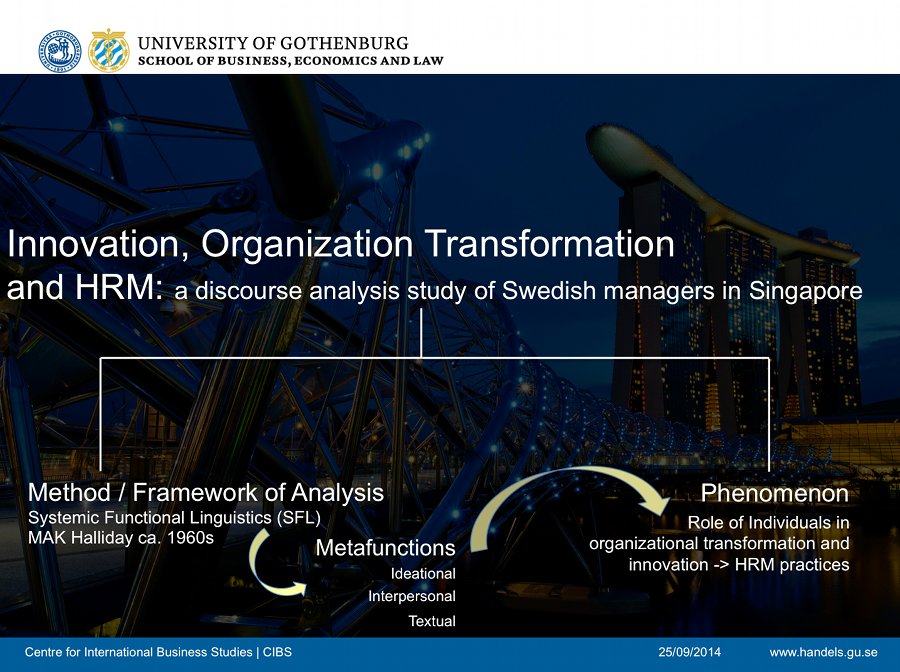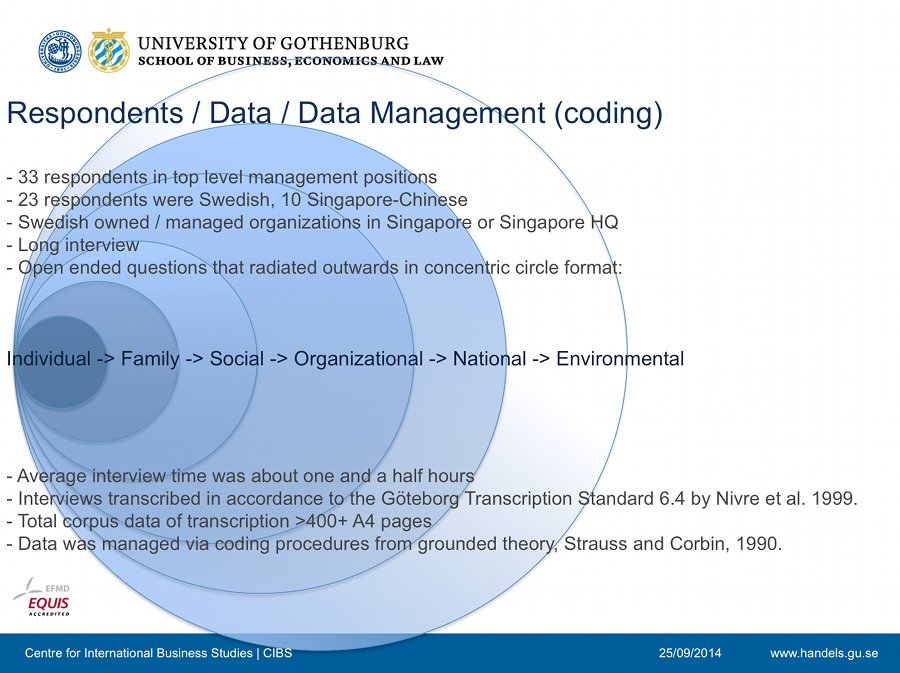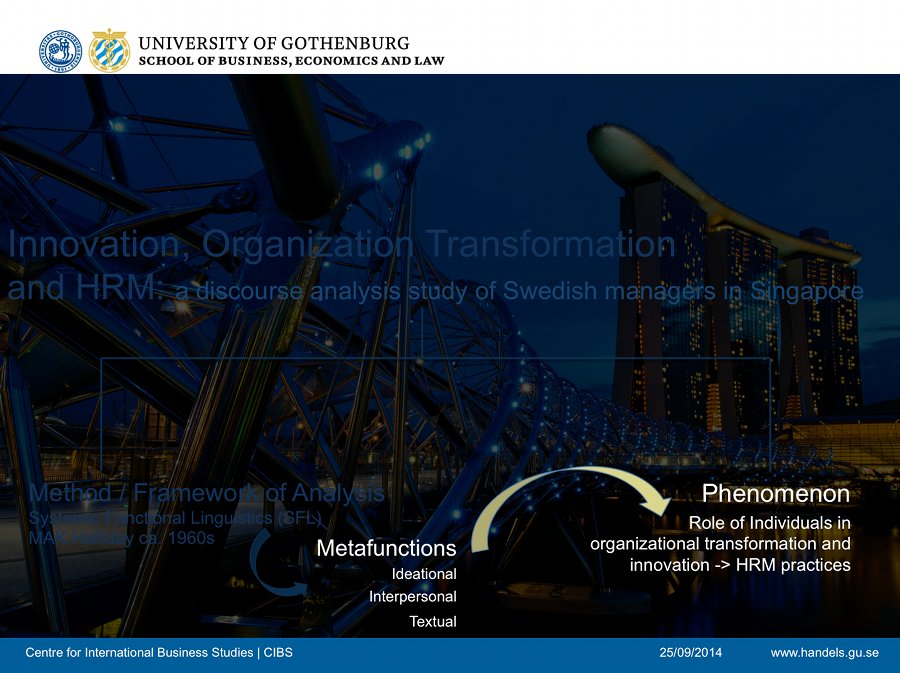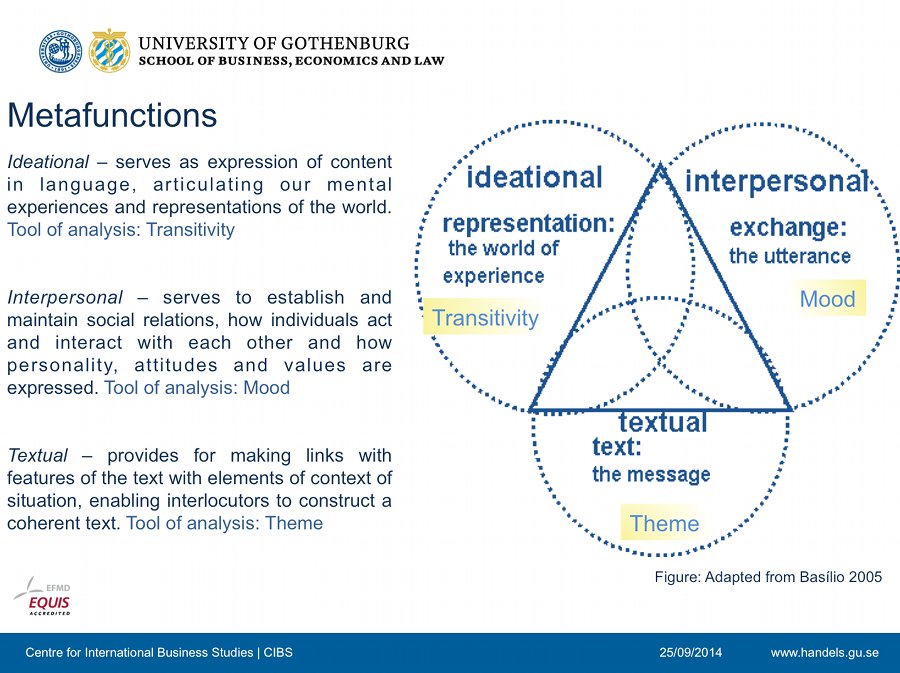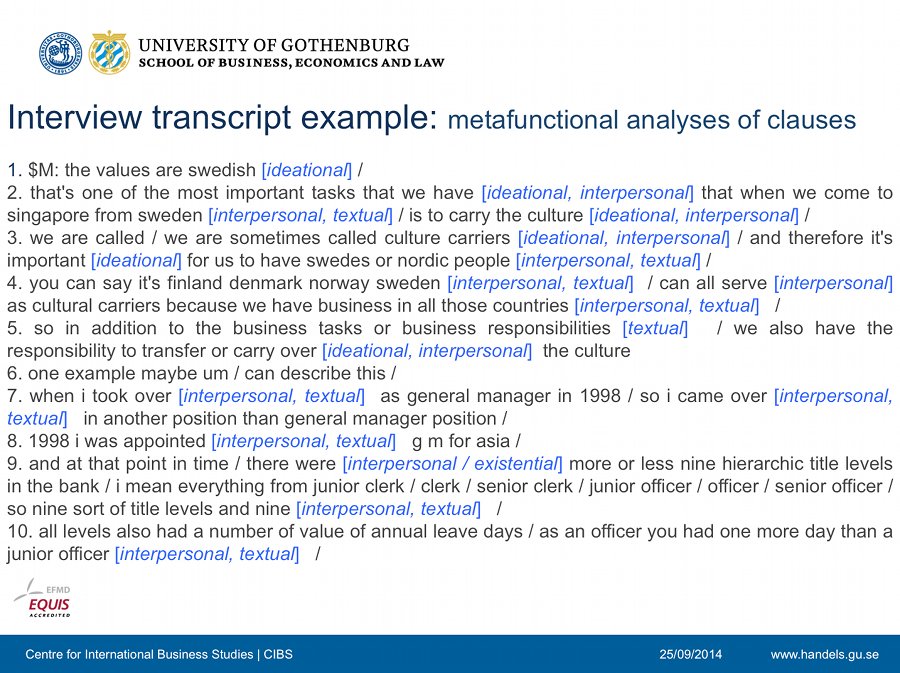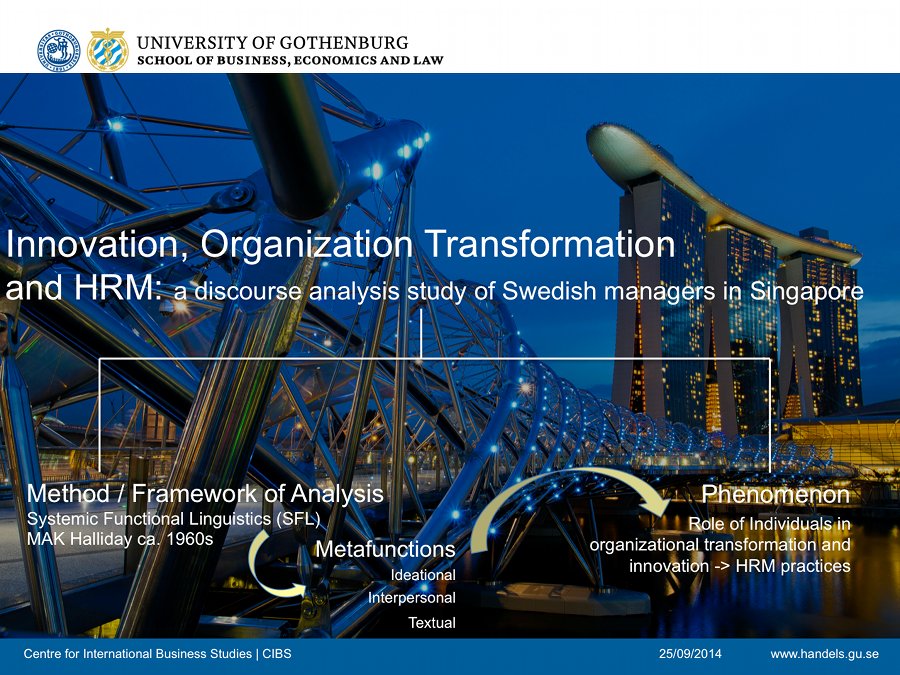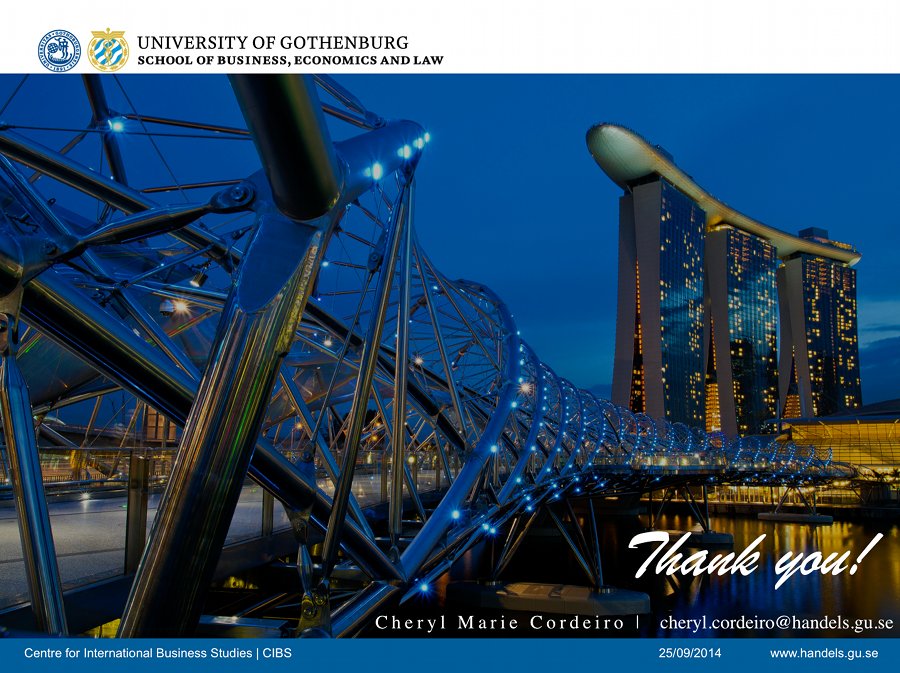The 7th IEEE International Conference on Management of Innovation and Technology (ICMIT 2014). 23-25 Sep. 2014. National University of Singapore, Singapore.
[R-slider id=”7″]
Innovation, organization transformation and human resource management: a discourse analysis study of Swedish managers in Singapore.
Abstract
Most studies investigating the relation between innovation, organization transformation and human resource management (HRM) have been quantitative in nature. The contribution of this study is to illustrate how these concepts can be analysed from a discourse analysis perspective. Using the three metafunctions of ideational, interpersonal and textual meanings from applied instrumental linguistics as method and framework of analysis, the study investigates the roles key individuals play in organizational transformation through HRM practices, and how that in turn might affect or influence organizational innovation. This study is an example of how organizational transformation, HRM practices and innovation within the organization can be viewed from a qualitative discourse analysis perspective
Keywords: innovation, discourse analysis, HRM, instrumental linguistics, organization transformation
[SLIDE 1]
I’ll be talking about innovation, organization transformation and human resource management from the perspective of applied linguistics, i.e. how discourse analysis can be used as a framework and tool in analysing organisational processes.
The findings presented come from a study based on the collected discourse of Swedish managers in Singapore, regarding their role in organization transformation and innovation. This study is part of a larger study on Swedish managers in Singapore, funded by the Anna Ahrenberg Foundation in Sweden [1].
In 1934, innovation, that referred to the adopting of new products (materia, technology) and processes (idea, behaviour) in the organization was already identified as being central to the heart of a firm’s survival and sustainability. An organization needs the ability to connect new ideas and markets.
The past few decades in particular have seen a growing interest in academia in the study of the firm’s innovative capacity as firms increasingly depend upon their ability to keep abreast with continuous business environment changes. A firm’s responsiveness, flexibility and adaptability are key strategies to its competitiveness and survival [2-7].
In most literature, innovation and human resource management (HRM) are closely connected, though it has been an under researched field [8]. Amongst the relatively small number of studies made of the connection between innovation and HRM practices, the development of a creative culture and an adept workforce could be argued to be catalysed by a number of key individuals with influence in the organization, that most often included top level managers [9-12]. The majority of such studies have also used mainly quantitative methods and frameworks of analysis.
This was mainly a qualitative study. It focused on the impact of the individual within the organization and how that individual, perhaps through HRM practices might influence organizational innovation.
[SLIDE 2]
There were two separate objectives of the study, something that is perhaps quite ambitious to have summarized in the six page article for the conference proceedings, but I have tried at the risk of incoherence.
The first objective has to do with applied linguistics itself, and how language can be used as a framework, as tools of analyses of discourse. This is a highly specific qualitative analysis approach to research, situated within the field of language and discourse studies -> critical discourse analysis -> using MAK Halliday’s systemic functional grammar (SFL) for analysing data.
[SLIDE 3]
This gives you an idea of the dimensions of SFL as a tool of analysis. SFL is an approach to linguistics that considers language as a social semiotic system. While language can be seen as a system of subordinated structures, the SFL perspective distinguishes between the available underlying structures and that of choice. So while many approaches to the study of language foregrounds the syntagmatic axis, SFL foregrounds the paradigmatic axis and adopts that as a point of departure of study.
The central theoretical principle is that any act of communication involves choices. Language is a system and the choices available in any language system creates a system network.
There are volumes of work done from the 1960s onwards on how language is a system of choice by the user, the use of which is chosen by the user to convey meaning and to complete a transaction. The advantage of SFL is that it gives you at the lexical and grammatical level of language analysis, a very systematic, technical manner in which to analyze language. And you can use SLF to generate machine readable results. So there is nothing subjective about the analysis of this type of framework. It’s extremely precise, following the grammatical categories of language.
[SLIDE 4]
This study makes use specifically of the three threads of meanings in language conveyed through the metafunctions that at any one time, is present when we use language.
Why study the metafunctions of language?
Because it is in this area of the SFL that explains the agency of action in ideas, how we experience events and situation, and it explains the workings of our interpersonal relationships.
I will expand a little more on the analysis of metafunctions later on, but here I’d like to mentally map for you, the dimension of SFL that was used / applied in this study.
[SLIDE 5]
The second objective of this study has to with the phenomenon to be studied, which in this case, is the role of individuals in organizational transformation and innovation and how that might be done through human resource practices within the organization.
And the three research questions put forth in this paper were:
i. What role do key individuals play in organizational transformation and HRM practices? What underlying processes of organizational transformation can be described?
ii. What relational processes can be described between key individuals and organizational transformation?
iii. How do key individuals, HRM practices and organizational transformation influence organization innovation?
[SLIDE 6]
To investigate the relationship between innovation, organization transformation and HRM, this study approached Swedish managers working in top level management positions in Swedish managed organizations in Singapore.
Singapore was chosen as a country of study due to its inherent cosmopolitan characteristics being a highly global city, and home to many important multinational headquarters.
The targeted group of respondents for the interviews were persons predominantly in leading or managerial positions, such as Managing Directors, Chief Executive Officers and Regional Directors etc. The respondents were randomly selected in the sense that no headhunting was conducted for any particular respondent, no one type of organization was targeted and no one particular industry was targeted.
As such, this study prioritised the selection of participants based on the fact that they were leaders in Swedish managed organizations working in a cross-cultural environment regardless of their age, sex, socio-cultural background and the industry field in which they worked.
The assumption was that it was these individuals who could catalyse transformational change within the organization. Many travelled around the region, because Singapore was the HQ for the Swedish Asian / Asia-Pacific operations.
To that end, 33 respondents were interviewed.
The long interviews were open ended, so the respondents were encouraged to speak and explore their topic of interest.
The questions pertained to various aspects of Swedish expatriate living and working in Singapore, beginning with the Individual, radiating outwards to questions about family, social living, organization living and working, to national and environmental.
They averaged about one and a half hours each. And then the interviewed were transcribed in accordance to the Göteborg Transcription Standard version 6.4.
So all in all, the resulting corpus was more than 400 pages of transcribed interview data. And the data was managed by a coding method from Strauss and Corbin in their work on grounded theory. Meaning to say that the findings of the study are corpus driven.
[SLIDE 7]
What can metafunctions tell us about the phenomenon studied?
[SLIDE 8]
As mentioned earlier, language has three metafunctions that come through at any one time when in use. So in the process of communication, whether in speech or in writing, three aspects of meanings are being conveyed simultaneously in the layers of metafunctions in language. These three aspects are the:
i. Ideational – which expresses the world of experience, language that captures our mental or cognitive experiences and representations of the world. The ideational metafunction is analysed via the use of transitivity in language. It tells us about who is doing what and who feels or thinks what, for example.
ii. Interpersonal – language that establishes and maintains social relationships, it reflects how individuals interact with each in social contexts, what values, attitudes and what aspects of each individual’s personality is expressed. The interpersonal metafunction is analysed via the use of Mood and modality, how obliged do people feel about doing something for example.
iii. Textual – which brings out the themes of what is being communicated, it helps interlocutors construct a coherent text. The textual metafunction is analysed by looking at clausal theme, i.e. what comes first when people say things.
[SLIDE 9]
Here is a ten lines example of part of an interview, analysed using the various metafunctions only. The advantage of using SFL is that you can have different detailed levels of analysis, this one shown here touches the surface. The analysis can then be quantified by the number of occurrences of phenomena. So the nuances the nuances of the ideational, interpersonal and textual metafunctions are not shown here in this example.
[SLIDE 10]
Some results from the analysis of metafunctions.
What is the role of individuals on HRM processes, organizational transformation and organization innovation?
Ideationally speaking, the language use reflects that Swedes who find themselves in Singapore as top managers and leaders of organizations think of themselves as ‘culture carriers’ or ‘culture bearers’, who have the responsibility to bring over the Swedish culture and values to the Singapore subsidiary. To that effect then, the ideational goal is for the Swedish managers to make an impact on the Singapore subsidiary in terms of influence. The kinds of influences include communication processes, so we had one managing director who personally re-wrote the employee handbook. She lateralized the organization, taking down the existing nine hierarchies to make only three hierarchies, like how she knew it to be in Sweden. She took away the middle managers and made individuals more open for responsibility, in effect, they had to take up more responsibility because they had no ‘boss’ to turn to. The resulting effect of putting this change on them is that people in turn became not only more independent, but bolder and more creative. They were empowered to make decisions and to follow up on the outcomes. Still, ideationally, if mistakes were made, it was the top Swedish manager, or managing director who took responsibility for poor decisions made on the part of the employees.
Interpersonally, if you looked at the analysis of Mood, you can find a trend of high obligation put from Swedish top managers to their employees of organizational change. It was not okay if the structures of the organization were too rigid or too many hierarchies. It was imperative that the employees spoke more to each other, shared more information with each other, it was imperative that they took on greater responsibility, the structures of the organization made it so too that there was nobody to turn to for a solution except between themselves. To that extent then the boss, the Swedish boss was not seen as ‘the boss’ anymore but rather, as a mentor. There is on the other hand, a low obligation to get things perfect, meaning to say, it’s alright if mistakes were made, mistakes are allowed, open communicaton is encouraged and mistakes are taken as lessons to be learnt. Learning is high obligation, but negative feedback as ‘punishment’ is low obligation, or non-existent. And while there is high obligation to change, the time needed for change to occur is low on the modality meaning to say that the process of change was allowed to take its own time, under certain guidance or mentorship.
Thematically, and textually, what is revealed is the constant ‘boss as mentor’ and ‘greater individual responsibility’ when it comes to creating a new paradigm of working within the organization. You also get to understand that organizational change is painful. It’s not always pleasant and there was resistance to chance. What often occurs as theme is also that the Swedish managers emphasize continuously, a need to think outside the box, or that there is even no box. Do what works, see what works for the situation, given the information and knowledge, work with that.
The effect of such restructuring, the flattening of hierarchies, the taking away of the immediate middle ‘boss’ and putting everyone in contact with each other is to actually cultivate and foster an environment that begins to be conducive for the exchange of ideas and to encourage new ideas to form. Imagine taking down the borders between organizational levels, departments and then forcing people to come up with solutions to everyday problems, where you necessary need to cross-skills and cross-knowledge. So one of the results was that the managing director also came to understand the talent of the employees better, she was better able to understand their capacity and what they were good at.
[SLIDE 11]
In conclusion, it might have been difficult to convey the two aspects of the paper, but hopefully it lends some insight into the very concrete possibility of using linguistics as a framework and tool of analysis in order to understand the actorship of individuals. What top managers were able to influence and how the processes of change took place. An SFL analysis can potentially give you a detailed understanding of how an organization can become more innovative or fosters an innovative culture, locating agency and actorship responsibility in the process. It can also tell you about the phenomena itself, how these different agents connect during the process of organisational change.
[SLIDE 12]
Thank you for listening.
References
[1] Cordeiro-Nilsson, C.M. 2009. Swedish management in Singapore: a discourse analysis study. Doctoral thesis, Department of Philosophy, Linguistics, and Theory of Science. University of Gothenburg. Internet resource at GUPEA, University of Gothenburg, http://hdl.handle.net/2077/20233.
[2] Wolfe, R. A. 1994. Organizational innovation: review, critique and suggested research directions. Journal of Management Studies, 31(3):405-31.
[3] Clark J. / Guy K. 1998. Innovation and Competitiveness: A Review, Technology Analysis & Strategic Management, 10(3): 363-95.
[4] Black, S.E. / Lynch, L.M., 2004. What’s driving the new economy? The benefits of workplace innovation. The Economic Journal, 114(493):97–116.
[5] Carpinetti, L.C.R. / Gerolamo, M.C. / Cardoza Galdámez, E.V. 2007. Continuous innovation and performance management of SME clusters. Creativity and Innovation Management, 16(4):376-85.
[6] Deniz, M. / Seckin, S.N. / Cureoglu, M. 2012. Two strategic success factors for firm level competitiveness: innovation and cooperation. International Journal of Social Sciences and Humanity Studies, 4(2): 295-305.
[7] Choi, J.N. / Moon, W.J. 2013. Multiple forms of innovation implementation: the role of innovation, individuals and the implementation context. Organization Dynamics, 42:290-7.
[8] Leede, J. de / Looise J.K. 2005. Innovation and HRM: towards an integrated framework. Creativity and Innovation Management, 14(2):108-17.
[9] Bolwijn, P.T. / Kumpe, T. 1996. About facts, fiction and forces in Human Resource Management. Human systems Management, 15(3):161–72.
[10] Boxall, P. / Purcell, J. 2003. Strategy and Human Resource Management. Palgrave Macmillan, Basingstoke.
[11] Jimenez-Jimenez, D. / Sanz-Valle, R. 2008. Could HRM support organizational innovation? International Journal of Human Resource Management. 19(7):1208-1221.
[12] Keupp, M. M., Palmie, M. / Gassmann, O. 2012. The strategic management of innovation: a systematic review and paths for future research. International Journal of Management Reviews, 14:367-90.
